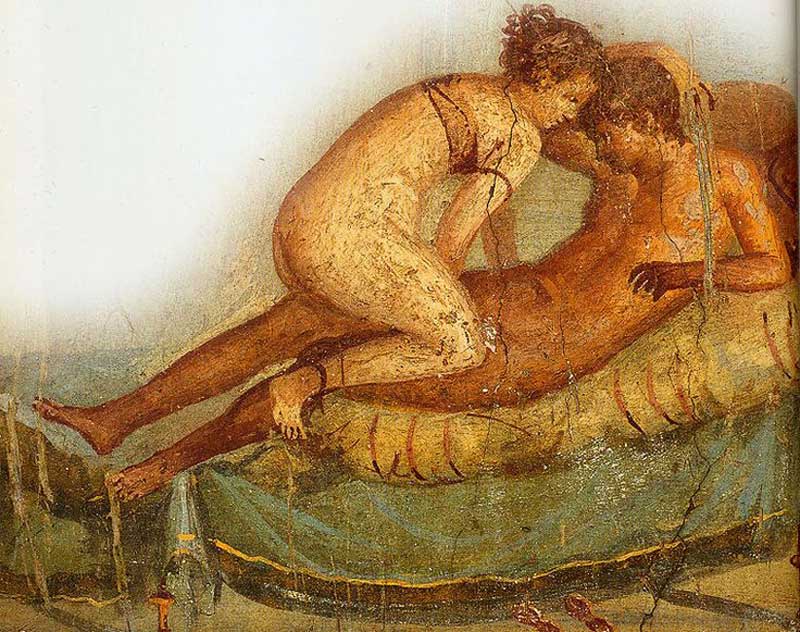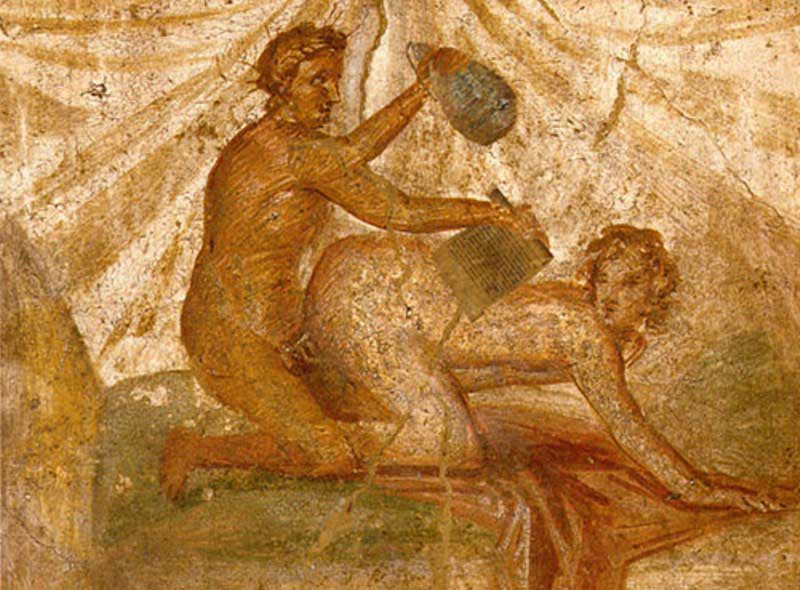
The ancient city of Pompeii, along with Herculaneum and the surrounding area, was destroyed in 79 AD, by a deadly eruption of Mount Vesuvius and remained buried for more than a century under the massive heaps of volcanic ash and pumice. Much later, during the excavation of the lost city in the mid-19th century, the archaeologists were shocked to discover a wide range of erotic art displayed all over the ancient city, in private houses, public buildings and even on the street façades.

There are different categories of erotic art that were found in the frozen city in different contexts. A particularly common find are phalluses and images of Priapus, the god of fertility, protector of horticulture with his enormous penis.
They are conspicuously present in paintings and mosaics, in the form of decorative lamps and one even on a street, carved into a paving stone. It is considered by many that, apart from erotic symbols, the presence of Greek god Priapus with his huge erect penis might have been intended as a charm to ward off the ‘evil eye’ and ensure prosperity and perhaps for that reason, a large wall-painting of Priapus enfaced the entrance to the House of the Vettii in Pompeii.

However, there are other categories too, which are extremely sexual in nature. There are ample mythological scenes, most commonly scenes presenting Venus and Mars or Pan with a nymph, are displayed in different rooms of private houses. Apart from that, more explicit and realistic scenes were found in bedrooms and back rooms of some buildings which might have been brothels. In fact, there are many evidences of prostitution in Pompeii and researchers believe the erotic paintings depicting group sex and other acts might have indicated the services offered by the prostitutes.
The Lupanar (Latin for wolf’s den) of Pompeii was the central point for the doomed city's thriving red light district. There was a time when the sex house was a favourite hangout for wealthy businessmen and politicians of Rome. It was a two-storey building with ten rooms and a latrine under the stairs. The most famous feature of the Lupanare is its erotic wall paintings. The paintings depicted different position for sexual intercourse and is believed to have been an advertising board for the types of services offered. Apart from the pictures, the walls of the brothel also bear the writings of the guests, boasting of their sexual prowess, as well as the prostitutes themselves.
According to Kelly Olson, a professor of the Western University, Lupanare was not a very nice place to work. It consisted of small and dank rooms, which were rather dark, windowless and uncomfortable, separated from the anteroom only by curtains. The rooms were equipped with a stone bed covered with a mattress, where a prostitute would entertain her clients. In those rooms, Married men could sleep with anyone as long as they kept their hands off other men's wives. Prostitutes in the brothel were not exclusively women. They were both female and male and serviced the needs both male and female clients. It was estimated that, there were 9 to 35 brothels in Pompeii and most of the prostitutes in Pompeii were slaves of Oriental or Greek origin.


Initially, the erotic art and objects were considered as too obscene to be viewed by the general public and were kept under lock and key by order of the Bourbon King Charles III. Later, in 1817, a ‘Secret Cabinet’ was created in which those items were displayed at the Royal Museum at Naples, but only important male visitors were allowed to get inside, with specific permission. After that, it was closed and opened many times and was briefly made accessible again at the end of the 1960s, during the period of sexual revolution. It was finally re-opened for public viewing in 2000. However, minors are allowed, only in the presence of a guardian or with written permission.

It is interesting to note that, though the brothel is neither the most luxurious nor the most important historic building in the ruined city of Pompeii, it is the most frequently visited spot by tourists from across the world.